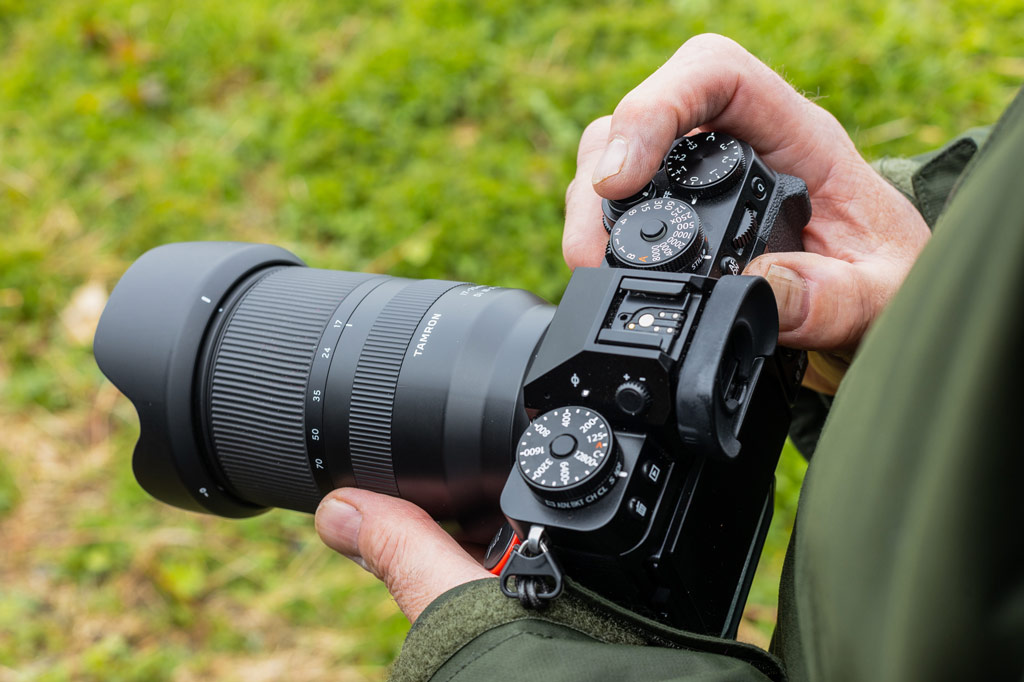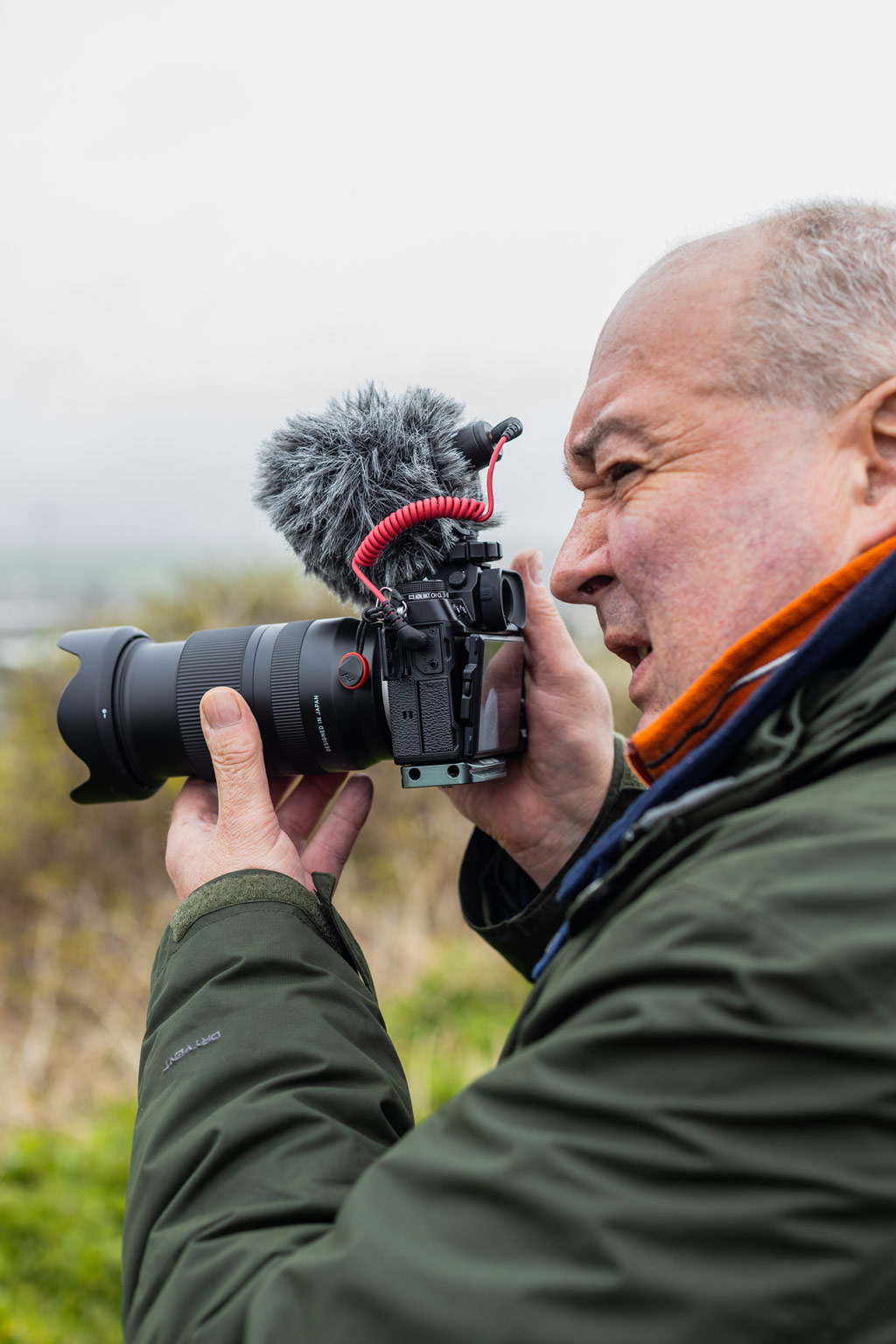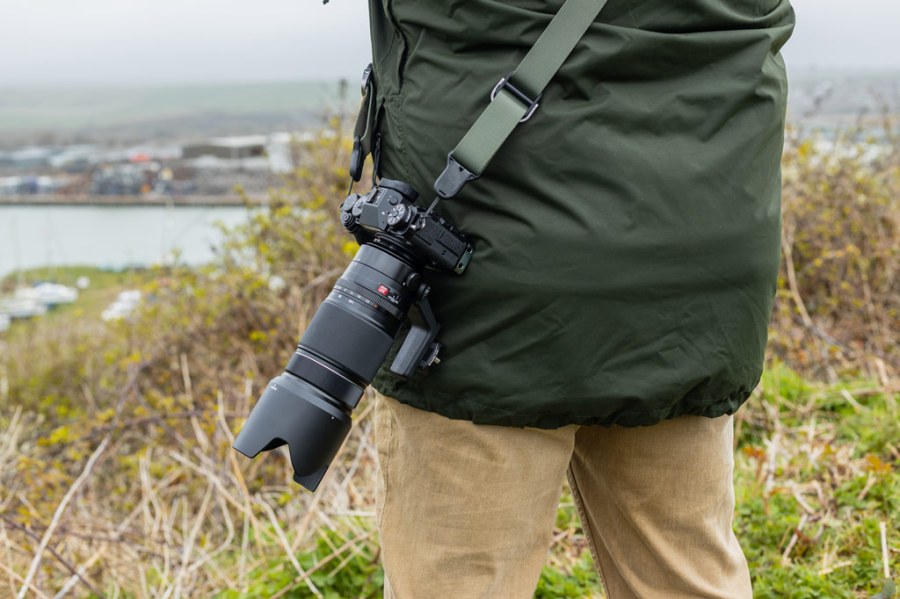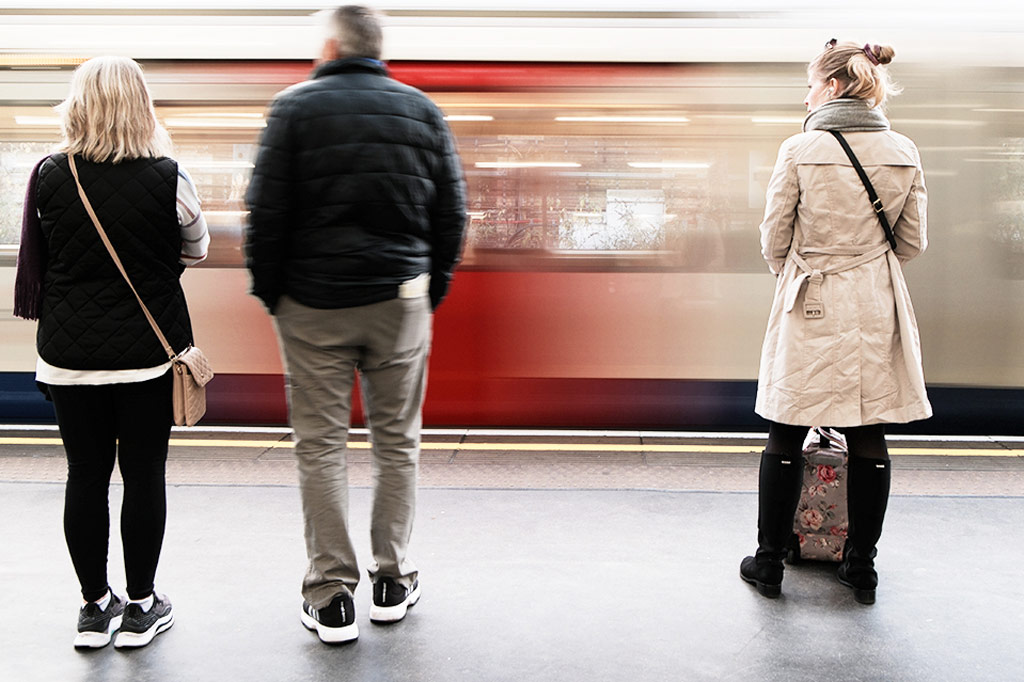My first experience of Fujifilm cameras was in the 1990s with the specialist 6×17 panoramic film camera. In 2014 I needed a new everyday carry camera and opted for the new Fujifilm X30 digital compact which introduced me to the joys of straight out of camera JPEG files and film simulation settings. For the following six years, I continued to use Canon full frame and crop sensor DSLRs for my commercial location and studio photography.
Fujifilm X-T5 at a glance:
- 40.2MP APS-C sensor
- 425-point AF
- AI subject recognition
- ISO 125-12,800 native 51,200 extended
- 15fps stills shooting
- 6K 30fps video
Late in 2022, I decided that it was time to move from full frame DSLR to crop sensor mirrorless in order to reduce the weight and bulk of the gear I carry. For the past 10 years I’ve used portable battery flashes on location and now in the studio, going mirrorless is a natural progression for me.
I looked at the various options from Canon having been a loyal user since the introduction of the EOS 5 film camera in 1992. Sadly, the cost of Canon mirrorless bodies and RF lenses was prohibitive, and at the time of writing Canon had not released the intellectual property to enabled third party lens providers to manufacture RF mount lenses.
Fortunately, I have a long relationship with Park Cameras in Burgess Hill who had an early stock of the Fujifilm X-T5. After much indecision, I took the plunge and bought an X-T5 body and selection of lenses, including the Tamron 17-70mm f/2.8 Di III-A VC RXD lens for Fujifilm X-mount, based on the proven (Model B070) for Sony E-mount cameras. I don’t mind admitting that Andy Westlake’s review of the Fujifilm X-T5 influenced my decision.
Fujifilm X-T5 Build and Handling
I now have a camera system which is both light, compact and easy to use. The design harks back to the days of 35mm film cameras with dials on the top plate for ISO sensitivity, shutter speed and exposure compensation. Even the shutter release button is reminiscent of a film camera with the on/off switch, which would have been the shutter button lock and a thread to take a cable release for long exposures. The ISO and shutter speed dial button locks to prevent accidental movement. The exposure compensation button does not, but I can see why – when the camera is at eye-level exposure can be adjusted with your thumb and forefinger with ease.

The Fujifilm X-T5’s design with its separate dials reminiscent of classic film cameras. Photo Credit: Dawnie Thompson
Under the ISO dial is a control ring that allows you to dial-in in-camera HDR (High Dynamic Range), frame rates for single, low and high speed continuous frame rates, bracketing, advanced filters and panoramic shooting. This control ring is easily knocked when removing from a bag or when shooting which is inconvenient, especially when you think that you’re in high speed continuous mode and you’ve knocked it into single-frame mode! The exposure compensation dial is also susceptible to being moved when removing the camera from a bag or when using a sling strap.
In use the X-T5 sits comfortably in my hands with a good finger and thumb grips with access to all controls. At the time of writing, I’ve used the camera for around four months and it’s been with me for work assignments and as a daily carry camera in a Tenba Axis holster case with the Tamron 17-70mm f/2.8 Di III-A VC RXD lens attached.
Fujifilm X-T5 and In Body Image Stabilisation

Thanks to the built-in image stabilisation of the Fujifilm X-T5 you can shoot handheld at slow shutter speeds. (1/6 sec, F5.6, ISO 640) Photo Credit: Ian Pack
For many photographers owning the Fujifilm X-T5 will mean a tripod or monopod will be used less as the 7EV IBIS (In Body Image Stabilisation) is very good. It’s possible to achieve shutter speeds as slow as ¼ second and have a sharp image. Not carrying a tripod will appeal to many photographers on the move. IBIS will not completely obviate the need for additional support where accurate frame registration is needed such as using the pixel shift function, astrophotography, multiple exposures or composite images which are common in my commercial photography work.
When using a tripod you do need to turn off the IBIS otherwise you’ll end up with unsharp images. This can be done via the camera menus, a switch on the lens and in some cases both. So far I’ve not used my X-T5 with a tripod but intend to programme one of the external buttons as a short-cut for future use. When not in use the tripod mount on Fujifilm telephoto zoom lenses detaches with two thumb screws making hand-holding much easier.
Another scenario where turning off IBIS and OIS (Optical Image Stabilisation) which is found in some lenses is when shooting video using the internal camera microphone or a microphone mounted on the camera hotshoe. The microphone will pick up the whirring of the stabilisation mechanisms creating an annoying low-level hum on the audio tracks.

To avoid noisy audio from the autofocus mechanism use an external microphone. Photo: Dawnie Thompson
Fujifilm X-T5 for Video
If you do decide to use the X-T5 for filming video it’s a very capable camera although not in the league of the Fujifilm X-H2s. I do shoot video and it represents less than 20% of my work so the X-T5 is the perfect companion as it’s a camera primarily designed for stills photographers who shoot a little video. I have shot a test video with IBIS and OIS on, using the internal microphone and the whirring noise is not acceptable. The only way around using IBIS and OIS when shooting video handheld is to use an off camera microphone where if you’re on the move, as it’s likely you will be, you’ll need someone to hold the microphone on a boom.
High ISO performance is very good. Whilst I expected grain, I was surprised at how little noise there was in the darker image tones. This also helps as I’ve started using Rotolight’s NEO 3 Pro and AEOS 2 Pro lights and higher ISO settings in the region of ISO 1,250 as needed to achieve balanced exposures. If noise is an issue I use DxO’s PureRAW to clean up the RAW files.

The Fujifilm X-T5 performs well with high ISO settings, showing minimal noise (ISO 2500, 1/25sec, F13) Photo Credit: Ian Pack
Fujifilm X-T5 Autofocus performance
There’s much debate amongst photographers about the autofocus performance. Like any new gear, experimentation is needed to see what settings work for your particular style of photography. Within the AF/MF menu, you can select 117 or 425 AF points along with face and subject detection.
So far I’ve tried animal detection as I am part-time carer/walker for our daughter’s fox red Labrador. In tests with 117 focus points selected, continuous AF and animal subject detection the camera captured sequences of Otto running across the frame and toward the camera in overcast cloud and bright late afternoon sun, maintaining focus on his head, running the shutter at continuous high speed until the buffer filled. The camera can detect a Labrador at around one hundred meters down range in low contrast conditions.

The Fujifilm X-T5 features animal subject detection. (F4, ISO 800, 1/1,800sec) Photo Credit: Ian Pack
Now I’m getting to grips with the subject focus I will experiment more, especially with birds in flight. Spotting flying birds with the Fujifilm XF 100-400mm f/4.5-5.6 R LM OIS WR telephoto zoom lens is particularly challenging.
Fujifilm X-T5 Face Recognition
With so many focus points it’s easy to select your point of focus as there’s a multi-directional control on the rear of the camera positioned close to where your thumb sits. I find this very useful work at both eye level and with the flip out display. Although the display is not fully articulated it’s perfect for low and high level shooting in both landscape and portrait orientation.
The face/eye recognition is particularly useful for wedding, portrait and event photographers. It works well in low light levels but struggles when the sun or other bright light source is behind the model. It also can struggle where the model wears eyeglasses or has a hat with a peak or brim.

The Fujifilm X-T5 face detection may struggle in backlit sunny conditions. Photo Credit: Ian Pack
Fujifilm X-T5 storage and file handling
Fujifilm has a reputation for the way their cameras handle colour. This is the first time in many many years that I’ve felt confident using JPEG files straight out of a camera. There is the option of Apple’s HEIC or HIF files which offer better compression and take up less storage space. If you’re an Apple user this is fine, but Windows users will need to download and install a special Codec in order to read the HEIF files.
My camera is set to record both Fujifilm’s RAF RAW files and normal JPEG files which at 40mp are a respectable 7,728 x 5,125 pixels. Based on current use only about 20% of the RAW files are processed, the rest of the time resizing JPEG files for primarily online use. The images in this article are a mix of JPEG and RAW files.
Fujifilm X-T5 White Balance and Built-in Film Effect
The Auto White Balance is very good compared to my Canon DSLRs. It handles mixed lighting from architectural LED luminaires and daylight surprisingly well. With my Canon cameras, I used to set Daylight white balance as the basis for post-processing and colour grading. Fujifilm has utilised AI Deep Learning technology to identify warm orange tones to improve AWB accuracy. It is possible to set custom or preset white balance or even fine tune AWB to your liking.
Built into the camera are nineteen film simulation settings including variations for Standard, Vivid, Soft, and Chrome. These equate to Fujifilm’s classic E6 transparency emulsions PROVIA, VELVIA, ASTIA, Kodak’s classic Kodachrome, plus colour negative, black & white, cinematic and sepia. By recording both JPEG and RAW files I know that I have options in post-processing as the JPEG file records the film simulation data and the RAW file the data from the camera sensor.
Fujifilm X-T5 connectivity issue with Instax Printers
Under the Network/USB setting menu is an item showing Instax Printer Connection Setting. With this in mind, I thought it would be an idea after my daughter’s graduation to pop into the Fujifilm House of Photography in Covent Garden, London and get a few prints made. This was not to be the case as the shop staff could not get the feature to work. Subsequently, I’ve communicated with Fujifilm who advise that Instax printers will not connect to the X-T5 and other X-Series cameras as Instax printers use Bluetooth connectivity and that the option is embedded as many Fujifilm cameras use the same menu structure.
In order to create prints from the camera I needed to load the Fujifilm Camera Remote app and connect via Bluetooth which seems to be very hit and miss. Ultimately I removed the SD memory from the camera and connected it to my iPad via a USB-C hub.
I will persist with both Wi-Fi and Bluetooth connectivity as the ability to shoot tethered is very useful, especially in the studio.
Fujifilm T-X5 Battery and Charger
Now I have a lighter weight and more compact camera system I will venture out with the intention once again of photographing for pleasure. The Fujifilm X-T5 body with Tamron 17-70mm attached, Fujifilm 10-24mm ƒ/2.8 and 50 – 140mm ƒ/2.8 zooms all fit in a Tenba BYOB 10 along with spare batteries, SD memory and a couple of filters. This slips into an average 20 or so litre backpack or my trust Domke F2 for the total retro look.
The camera does not come with a battery charger so I invested in a Newell charger and a couple of Newell WP26 equivalent batteries. The Newell charger is slow to charge a single WP26 battery, around 4-5 hours. I will be looking for a faster charger, although I know this potentially will reduce battery life. In normal use battery life is stated at around 700 frames. So far I’ve not needed to change a battery during a day as I got into the habit of a fresh battery and memory cards at the start of a shoot from the early days of shooting with digital cameras.
It’s useful having two SD memory slots. These can be set up in various configurations including recording to both simultaneously. This is ideal where an immediate back-up is needed. For extended memory capacity, it’s possible to record to one and then the next SD card.
Fujifilm X-T5 Verdict
I’m now looking into buying my next Fujifilm X-Series camera body. It’s likely that I will opt for a second X-T5 body as I’ve always photographed with two cameras in order to reduce the hassle of changing lenses. Also, with digital cameras, there’s always the danger of the ingress of dust polluting the camera sensor.
If, like me, you are or were a dedicated full-frame fan, I’d seriously consider moving to the Fujifilm X-T5. The gear is reasonably priced, lenses are available from a number of manufacturers and generally, the lenses are smaller and lighter than comparable full-frame DSLR and mirrorless cameras from other brands. I’m keeping a much reduced Canon system primarily for studio use.
When working with flash, I’ve not needed to change my flash system, just buy a Fujifilm compatible trigger.
Read our Fujifilm X-T5 review, or have a look at the best Fujifilm cameras.











